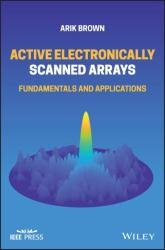Active Electronically Scanned Arrays: Fundamentals and Applications
- Добавил: literator
- Дата: 2-12-2021, 13:51
- Комментариев: 0
 Название: Active Electronically Scanned Arrays: Fundamentals and Applications
Название: Active Electronically Scanned Arrays: Fundamentals and ApplicationsАвтор: Arik D. Brown
Издательство: Wiley-IEEE Press
Год: 2022
Страниц: 275
Язык: английский
Формат: pdf (true)
Размер: 12.8 MB
В книге "Активные фазированные антенные решётки. Основы и применение" Арик Браун преподносит основополагающее изложение активных фазированных антенных решёток (АФАР), идеально подходящее для студентов и специалистов. Уважаемый автор предоставляет обзор первичных подсистем АФАР и подробные объяснения ключевых концепций конструкции и основ для подсистем, включая элементы антенны, модули передачи/приема и излучающие элементы.
In Active Electronically Scanned Arrays: Fundamentals and Applications, electromagnetics expert Dr. Arik D. Brown delivers a foundational treatment of active electronically scanned arrays (AESAs) ideal for engineering students and professionals. The distinguished author provides an overview of the primary subsystems of an AESA and detailed explanations of key design concepts and fundamentals for subsystems, including antenna array elements, transmit/receive modules, and beamformers.
An active electronically scanned array (AESA) is a type of phased array antenna, which is a computer-controlled array antenna in which the beam of radio waves can be electronically steered to point in different directions without moving the antenna. Performance results for various AESA architectures often found in industry, including analog, subarrayed, and digital beamforming AESAs, are discussed. With a focus on practical knowledge and applications, Active Electronically Scanned Arrays: Fundamentals and Applications offers an accessible overview of a technology critical to the implementation of collision avoidance in cars, air surveillance radar, communication antennas, and defense technologies.
For those unfamiliar with AESAs, they can seem very confusing and complicated. However, there are basic fundamental principles that drive how AESAs operate and what are key metrics for their performance. This book's goal is to provide the AESA beginner, whether a student, researcher, or practicing engineer, an understanding of why AESAs are critical technology, what are the primary subsystems in an AESA, key driving subsystem parameters that govern AESA performance, and various AESA topologies that are commonly implemented.
AESAs provide incredible capability working synergistically with downconverters, upconverters, exciters, and/or receivers. Having worked with AESAs for over 20 years, I have grown accustomed to thinking of the entire system from the AESA front-end elements to the backend electronics as the “AESA”, but in practice the AESA consists of the front-end array elements and the electronics used to provide signal conditioning, amplification, and beam steering. One of my colleagues (John Welch) and I had a friendly disagreement on what defined an AESA, and he'll be amused to know that I now agree with his definition. This discussion is relevant to this book as its chapters are organized in this manner.
The book also includes:
A thorough introduction to AESAs, including a top-level block diagram view and explanations of key components and subsystems
Detailed explanations of the impact of AESAs on mission applications including Radar, Electronic Attack (EA), Electronic Support Measures (ESM), SIGINT and Communications
Comprehensive explorations of antenna array elements, transmit/receive modules, and beamformers including their purpose, functions, and practical design considerations
In-depth examinations of AESA architecture performance for current and future systems
Utility of AESAs for implementing adaptive beamforming for Electronic Counter-Countermeasures (ECCM)
Perfect for electrical engineers working with active electronically scanned arrays, electronic warfare technologies, radar, or communications, Active Electronically Scanned Arrays: Fundamentals and Applications will also prove to be an invaluable resource for defense students undertaking military education and training.
Скачать Active Electronically Scanned Arrays: Fundamentals and Applications
[related-news] [/related-news]
Внимание
Уважаемый посетитель, Вы зашли на сайт как незарегистрированный пользователь.
Мы рекомендуем Вам зарегистрироваться либо войти на сайт под своим именем.
Уважаемый посетитель, Вы зашли на сайт как незарегистрированный пользователь.
Мы рекомендуем Вам зарегистрироваться либо войти на сайт под своим именем.
